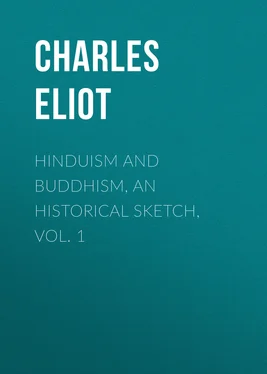Charles Eliot - Hinduism and Buddhism, An Historical Sketch, Vol. 1
Здесь есть возможность читать онлайн «Charles Eliot - Hinduism and Buddhism, An Historical Sketch, Vol. 1» — ознакомительный отрывок электронной книги совершенно бесплатно, а после прочтения отрывка купить полную версию. В некоторых случаях можно слушать аудио, скачать через торрент в формате fb2 и присутствует краткое содержание. Жанр: foreign_religion, Философия, Религиозная литература, foreign_psychology, foreign_antique, foreign_prose, на английском языке. Описание произведения, (предисловие) а так же отзывы посетителей доступны на портале библиотеки ЛибКат.
- Название:Hinduism and Buddhism, An Historical Sketch, Vol. 1
- Автор:
- Жанр:
- Год:неизвестен
- ISBN:нет данных
- Рейтинг книги:5 / 5. Голосов: 1
-
Избранное:Добавить в избранное
- Отзывы:
-
Ваша оценка:
- 100
- 1
- 2
- 3
- 4
- 5
Hinduism and Buddhism, An Historical Sketch, Vol. 1: краткое содержание, описание и аннотация
Предлагаем к чтению аннотацию, описание, краткое содержание или предисловие (зависит от того, что написал сам автор книги «Hinduism and Buddhism, An Historical Sketch, Vol. 1»). Если вы не нашли необходимую информацию о книге — напишите в комментариях, мы постараемся отыскать её.
Hinduism and Buddhism, An Historical Sketch, Vol. 1 — читать онлайн ознакомительный отрывок
Ниже представлен текст книги, разбитый по страницам. Система сохранения места последней прочитанной страницы, позволяет с удобством читать онлайн бесплатно книгу «Hinduism and Buddhism, An Historical Sketch, Vol. 1», без необходимости каждый раз заново искать на чём Вы остановились. Поставьте закладку, и сможете в любой момент перейти на страницу, на которой закончили чтение.
Интервал:
Закладка:
The Hun invasions were unfavourable to religious and intellectual activity in the north and, just as in the time of Moslim inroads, their ravages had more serious consequences for Buddhism than for Hinduism. The great Emperor Harsha (†647), of whom we know something from Bâna and Hsüan Chuang, became at the end of his life a zealous but eclectic Buddhist. Yet it is plain from Hsiian Chuang's account that at this time Buddhism was decadent in most districts both of the north and south.
This decadence was hastened by an unfortunate alliance with those forms of magic and erotic mysticism which are called Śâktism 24 24 As already mentioned, I think Śâktism is the more appropriate word but Tantrism is in common use by the best authorities.
. It is difficult to estimate the extent of the corruption, for the singularity of the evil, a combination of the austere and ethical teaching of Gotama with the most fantastic form of Hinduism, arrests attention and perhaps European scholars have written more about it than it deserves. It did not touch the Hinayanist churches nor appreciably infect the Buddhism of the Far East, nor even (it would seem) Indian Buddhism outside Bengal and Orissa. Unfortunately Magadha, which was both the home and last asylum of the faith, was also very near the regions where Śâktism most flourished. It is, as I have often noticed in these pages, a peculiarity of all Indian sects that in matters of belief they are not exclusive nor hostile to novelties. When a new idea wins converts it is the instinct of the older sects to declare that it is compatible with their teaching or that they have something similar and just as good. It was in this fashion that the Buddhists of Magadha accepted Śâktist and tantric ideas. If Hinduism could summon gods and goddesses by magical methods, they could summon Bodhisattvas, male and female, in the same way, and these spirits were as good as the gods. In justice it must be said that despite distortions and monstrous accretions the real teaching of Gotama did not entirely disappear even in Magadha and Tibet.
8. Later Forms of Hinduism
In the eighth and ninth centuries this degenerate Buddhism was exposed to the attacks of the great Hindu champions Kumâriḷa and Śankara, though it probably endured little persecution in our sense of the word. Both of them were Smârtas or traditionalists and laboured in the cause not of Vishnuism or Śivaism but of the ancient Brahmanic religion, amplified by many changes which the ages had brought but holding up as the religious ideal a manhood occupied with ritual observances, followed by an old age devoted to philosophy. Śankara was the greater of the two and would have a higher place among the famous names of the world had not his respect for tradition prevented him from asserting the originality which he undoubtedly possessed. Yet many remarkable features of his life work, both practical and intellectual, are due to imitation of the Buddhists and illustrate the dictum that Buddhism did not disappear from India 25 25 In India proper there are hardly any Buddhists now. The Kumbhipathias, an anti-Brahmanic sect in Orissa, are said to be based on Buddhist doctrines and a Buddhist mission in Mysore, called the Sakya Buddhist Society, has met with some success. See Census of India , 1911, i. pp. 122 and 126.
until Hinduism had absorbed from it all the good that it had to offer. Śankara took Buddhist institutions as his model in rearranging the ascetic orders of Hinduism, and his philosophy, a rigorously consistent pantheism which ascribed all apparent multiplicity and difference to illusion, is indebted to Mahayanist speculation. It is remarkable that his opponents stigmatized him as a Buddhist in disguise and his system, though it is one of the most influential lines of thought among educated Hindus, is anathematized by some theistic sects 26 26 See the quotation in Schomerus, Der Śaiva Siddhânta , p. 20 where a Saiva Hindu says that he would rather see India embrace Christianity than the doctrine of Śankara.
.
Śankara was a native of southern India. It is not easy to combine in one picture the progress of thought in the north and south, and for the earlier centuries our information as to the Dravidian countries is meagre. Yet they cannot be omitted, for their influence on the whole of India was great. Greeks, Kushans, Huns, and Mohammedans penetrated into the north but, until after the fall of Vijayanagar in 1565, no invader professing a foreign religion entered the country of the Tamils. Left in peace they elaborated their own version of current theological problems and the result spread over India. Buddhism and Jainism also flourished in the south. The former was introduced under Asoka but apparently ceased to be the dominant religion (if it ever was so) in the early centuries of our era. Still even in the eleventh century monasteries were built in Mysore. Jainism had a distinguished but chequered career in the south. It was powerful in the seventh century but subsequently endured considerable persecution. It still exists and possesses remarkable monuments at Sravana Belgola and elsewhere.
But the characteristic form of Dravidian religion is an emotional theism, running in the parallel channels of Vishnuism and Śivaism and accompanied by humbler but vigorous popular superstitions, which reveal the origin of its special temperament. For the frenzied ecstasies of devil dancers (to use a current though inaccurate phrase) are a primitive expression of the same sentiment which sees in the whole world the exulting energy and rhythmic force of Siva. And though the most rigid Brahmanism still flourishes in the Madras Presidency there is audible in the Dravidian hymns a distinct note of anti-sacerdotalism and of belief that every man by his own efforts can come into immediate contact with the Great Being whom he worships.
The Vishnuism and Śivaism of the south go back to the early centuries of our era, but the chronology is difficult. In both there is a line of poet-saints followed by philosophers and teachers and in both a considerable collection of Tamil hymns esteemed as equivalent to the Veda. Perhaps Śivaism was dominant first and Vishnuism somewhat later but at no epoch did either extinguish the other. It was the object of Śankara to bring these valuable but dangerous forces, as well as much Buddhist doctrine and practice, into harmony with Brahmanism.
Islam first entered India in 712 but it was some time before it passed beyond the frontier provinces and for many centuries it was too hostile and aggressive to invite imitation, but the spectacle of a strong community pledged to the worship of a single personal God produced an effect. In the period extending from the eighth to the twelfth centuries, in which Buddhism practically disappeared and Islam came to the front as a formidable though not irresistible antagonist, the dominant form of Hinduism was that which finds expression in the older Puranas, in the temples of Orissa and Khajarao and the Kailâsa at Ellora. It is the worship of one god, either Siva or Vishnu, but a monotheism adorned with a luxuriant mythology and delighting in the manifold shapes which the one deity assumes. It freely used the terminology of the Sânkhya but the first place in philosophy belonged to the severe pantheism of Śankara which, in contrast to this riotous exuberance of legend and sculpture, sees the highest truth in one Being to whom no epithets can be applied.
In the next epoch, say the twelfth to the seventeenth centuries, Indian thought clearly hankers after theism in the western sense and yet never completely acquiesces in it. Mythology, if still rampant according to our taste, at least becomes subsidiary and more detachable from the supreme deity, and this deity, if less anthropomorphic than Allah or Jehovah, is still a being who loves and helps souls, and these souls are explained in varying formulae as being identical with him and yet distinct.
Читать дальшеИнтервал:
Закладка:
Похожие книги на «Hinduism and Buddhism, An Historical Sketch, Vol. 1»
Представляем Вашему вниманию похожие книги на «Hinduism and Buddhism, An Historical Sketch, Vol. 1» списком для выбора. Мы отобрали схожую по названию и смыслу литературу в надежде предоставить читателям больше вариантов отыскать новые, интересные, ещё непрочитанные произведения.
Обсуждение, отзывы о книге «Hinduism and Buddhism, An Historical Sketch, Vol. 1» и просто собственные мнения читателей. Оставьте ваши комментарии, напишите, что Вы думаете о произведении, его смысле или главных героях. Укажите что конкретно понравилось, а что нет, и почему Вы так считаете.












